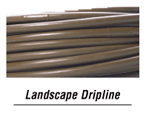I mentioned in the previous post (Watering with a Firehose: Drip Emitters) that there are two types of application when it comes to drip. Poly tubing with built in emitters is the second type of drip and perhaps more commonly used for Outdoor Living Spaces and flower beds than the emitters. 
Landscape dripline is little more than a glorified soaker hose and instead of distributing water to individual plants, relies more upon the flood irrigation method of watering. Dripline is poly tubing with evenly spaced emitters that release water slowly. The water spreads out a short distance from the tubing, but basically waters only right next to the tubing. There is an excellent application for dripline, and I will discuss this application in the next post.
Even though dripline uses less water than broadcast watering (sprays), it still does not conserve water like emitters do, largely because it waters bare soil. Dripline would therefore rank somewhere between emitters and sprays in efficiency when used for large flower, shrub and tree plantings.
Despite the lack of efficiency, dripline is still looked upon as a social statement, boldly declaring one’s green-ness to the world. I applaud sustainable landscapes for the money-saving strategies and responsible stewardship of our water resources, but perhaps dripline should not be lauded as the answer to saving and being responsible–at least when it comes to large perennial, shrub or tree plantings.
As I mentioned earlier, dripline works great for flood irrigation. This is best achieved by creating a grid with a supply line running around the perimeter of the area and dripline evenly spaced in parallel lines, crossing the area.
I commend you if you have installed dripline in your yard! You have taken great steps toward saving money and being responsible. Also, it is very simple to adjust dripline to a more efficient method.
Drip is an outstanding tool for creating a sustainable landscape.
When speaking of drip, there are two types of drip, each of which has an application for which it is best suited in your Outdoor Living Spaces or flower beds. In this post I will be describing the benefits and disadvantages of drip emitters.
In this post I will be describing the benefits and disadvantages of drip emitters.
Drip emitters, shown here at the right, are used with naked drip tubing (poly pipe with thin walls and no built in emitters.) These emitters are inserted into the drip tubing by puncturing the tubing with the barbed side of the emitter.
Once inserted, there are many techniques that can be used to get the water to the plant. My favorite is to attach 1/4″ spaghetti tubing to the open end of the emitter and then run the spaghetti tubing to the individual plants and use a stake and bug diffuser cap at the end to hold it in place. I know, confusing at first, but it actually is quite simple once you have done it a couple of times.
I love drip emitters! You can water hundreds of plants using this technique and the water only goes to the base of each plant. This reduces waste water and weeds because the bare ground is not getting watered.
Additionally, these work great with heavier clay soils that don’t accept the water very well because the water is applied at a much slower rate so it gives it time to sink in to the ground. Again, check the Three Things You Are Doing to Kill Your Lawn series of posts to understand why that is important.
Along those lines, there are several different types of emitters with the difference being how much water comes from each emitter per hour. I usually go with one gallon per hour on my emitters. At one gallon per hour, I will typically use one emitter for each one gallon or smaller perennial, two emitters for each three, five or ten gallon shrub and four emitters for each fifteen to twenty-five gallon or about one inch calliper tree.
The biggest disadvantage of drip emitters is the potential for them to get clogged. You must use a filter on your system to use drip and be very careful during repairs to not get dirt in the lines.
I have found, though that oftentimes your best friend is a clogged emitter. The reason I say this is because several plants, especially trees and shrubs, really don’t need much water in Utah outside of the snow pack from the winter and the occasionaly rain showers we receive. People, however, feel the compulsory need to water, and so a clogged emitter can prevent your plants from getting unneeded water.
An easy way to monitor whether your emitters are working or not is to use the finger test. Stick your finger in the soil after a watering around each plant and if the soil is moist, you are good. I would only check this once or twice a year and outside of that, I only check if a plant is starting to look somewhat dry. As I mentioned before, the success of your garden depends directly on the number of hours your shadow crosses it!